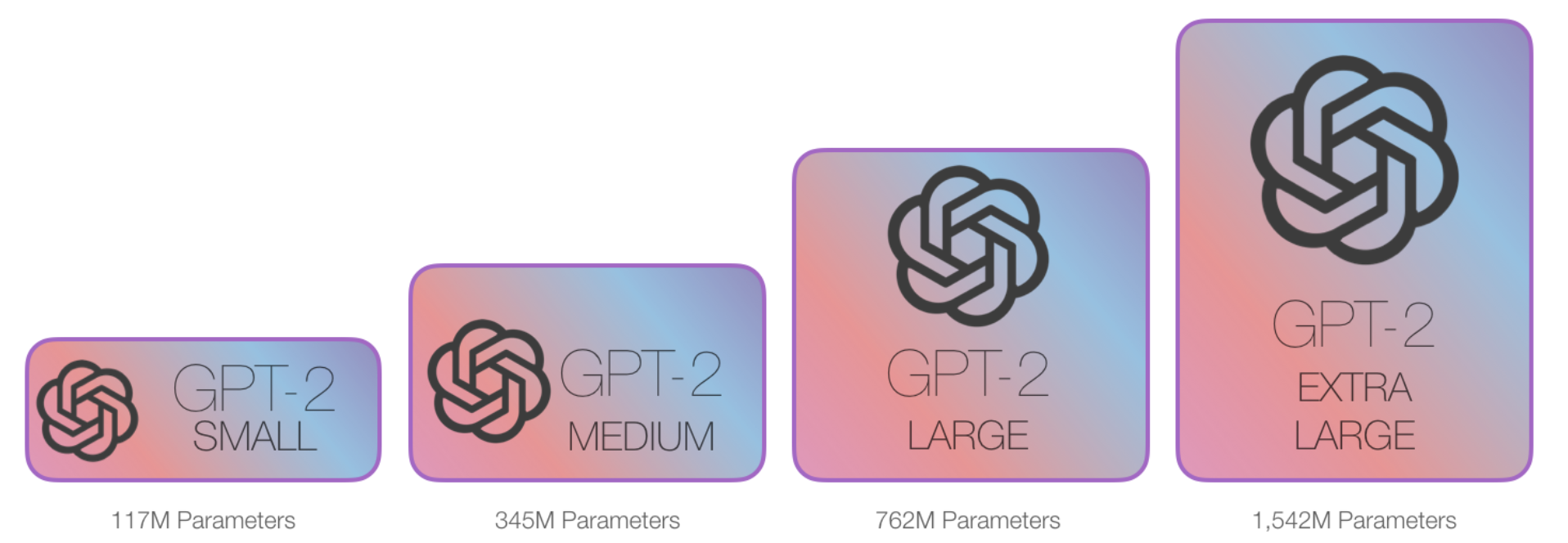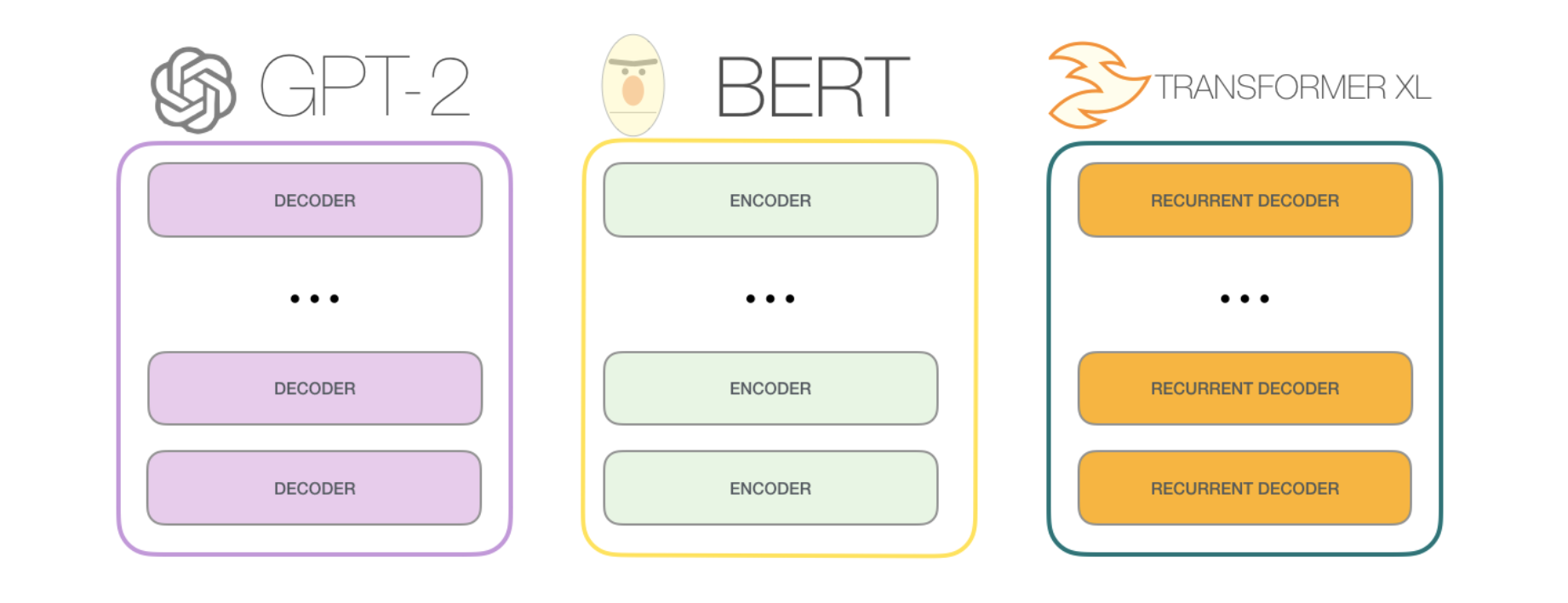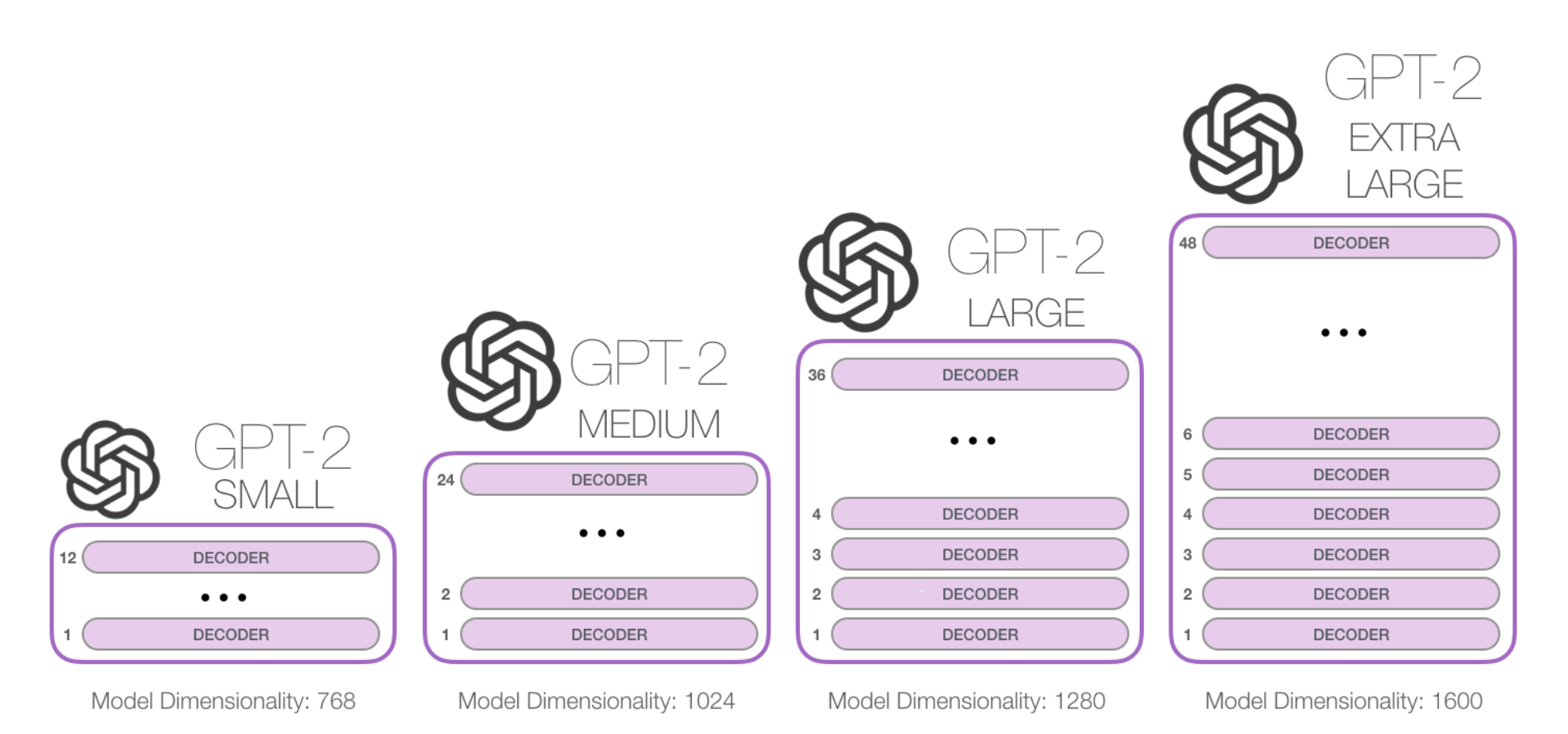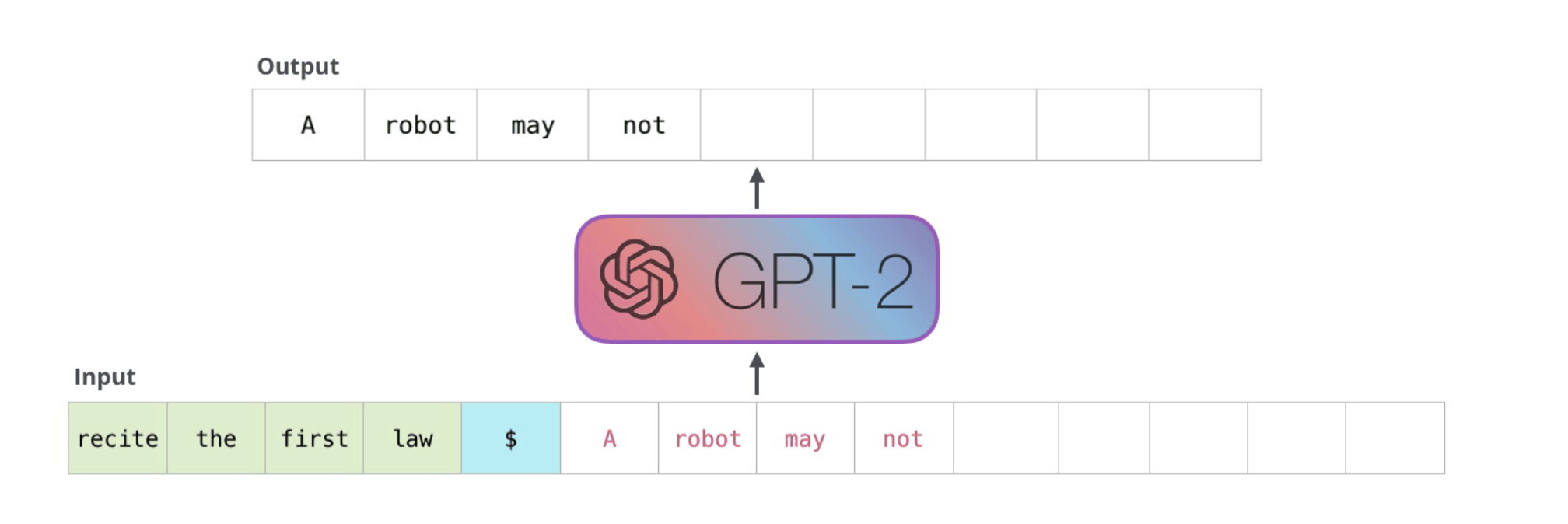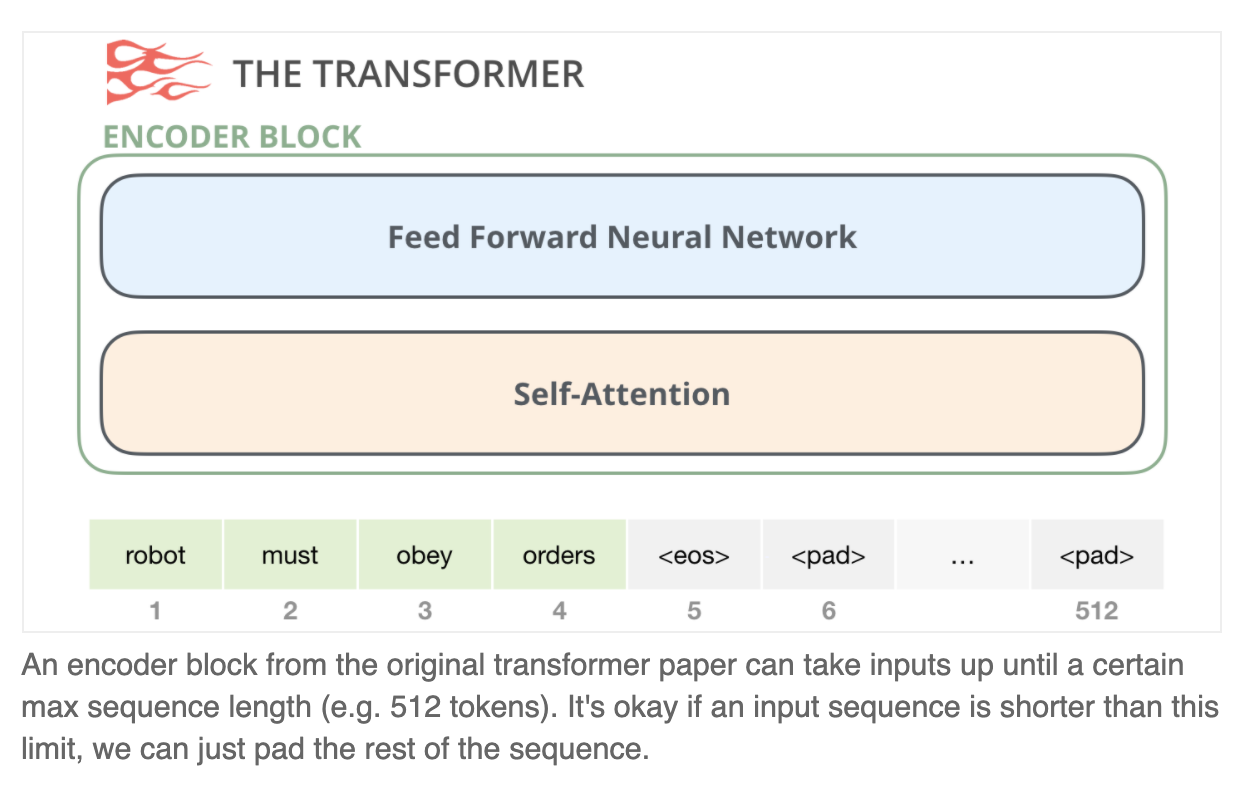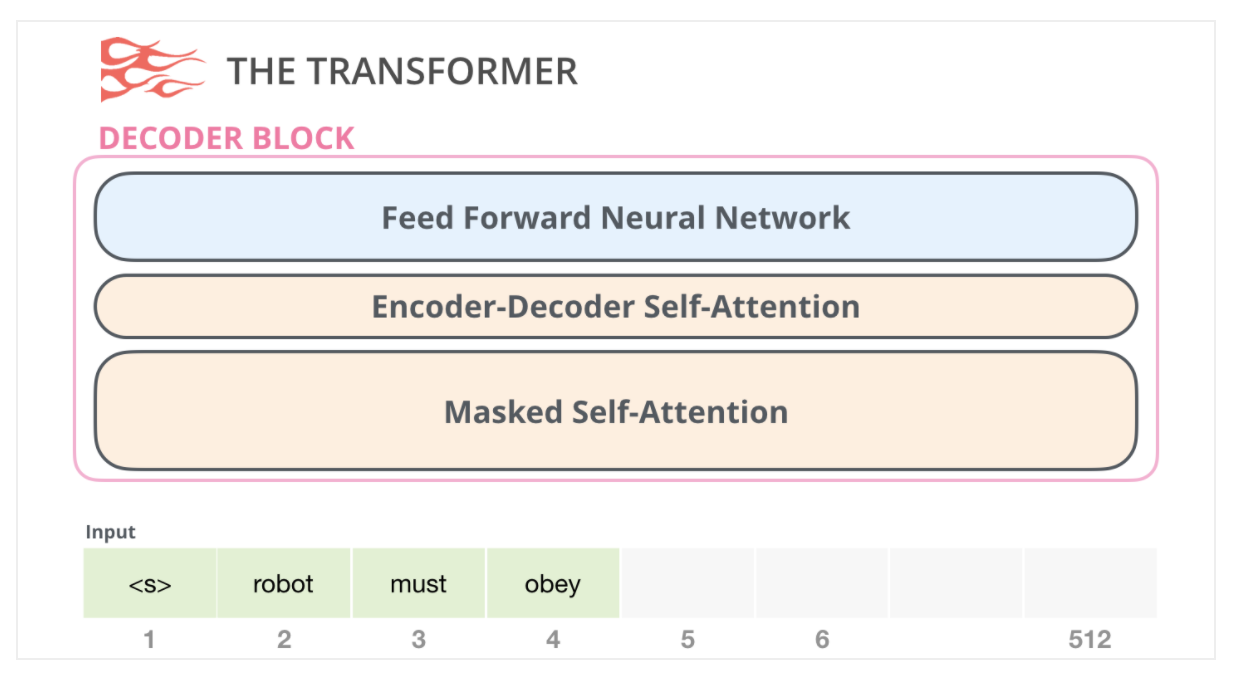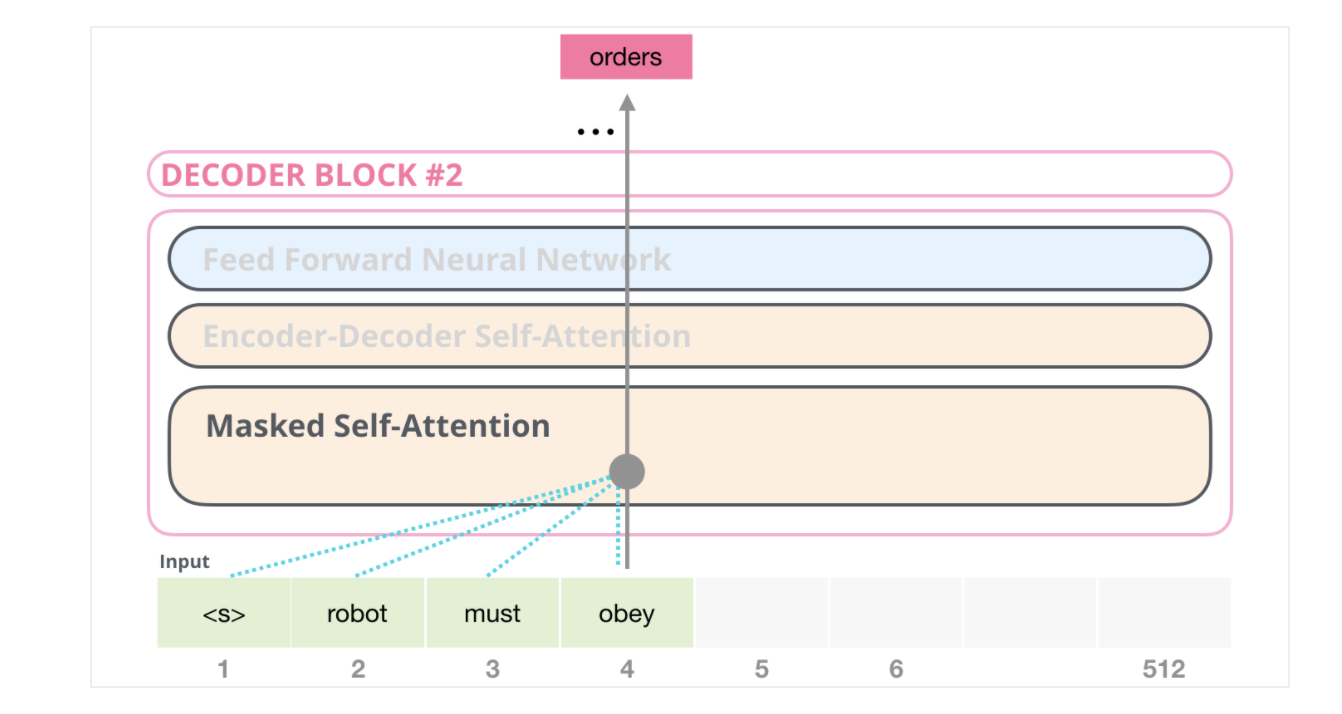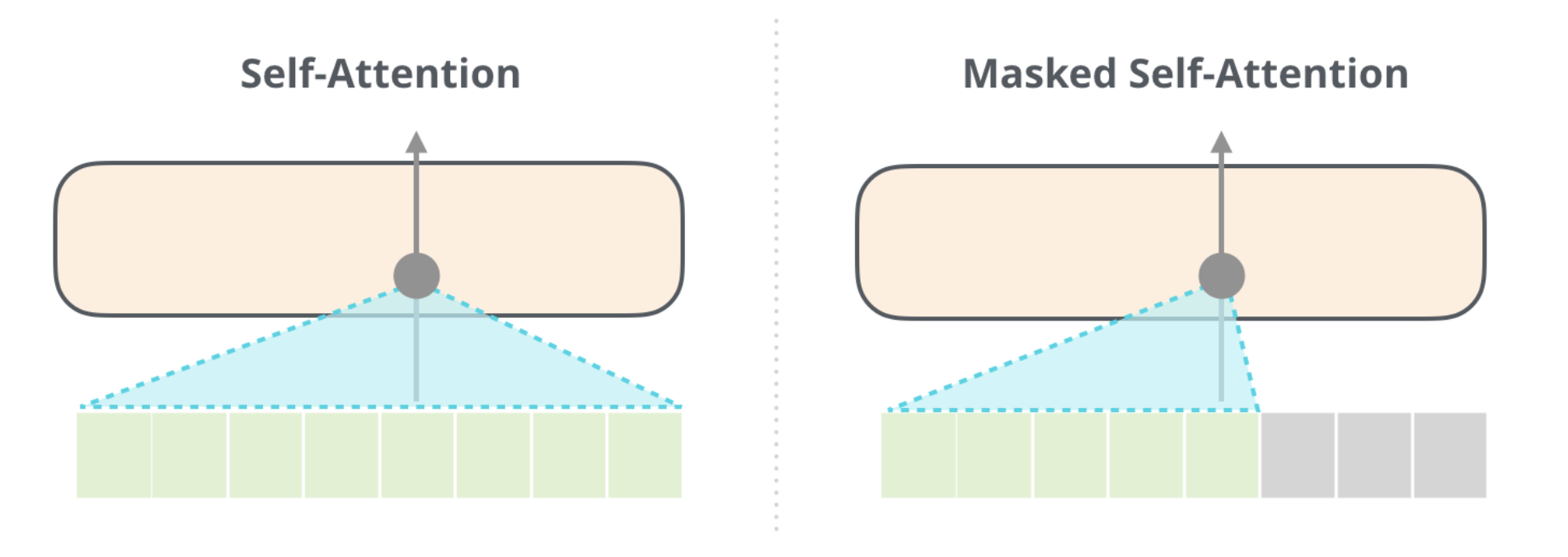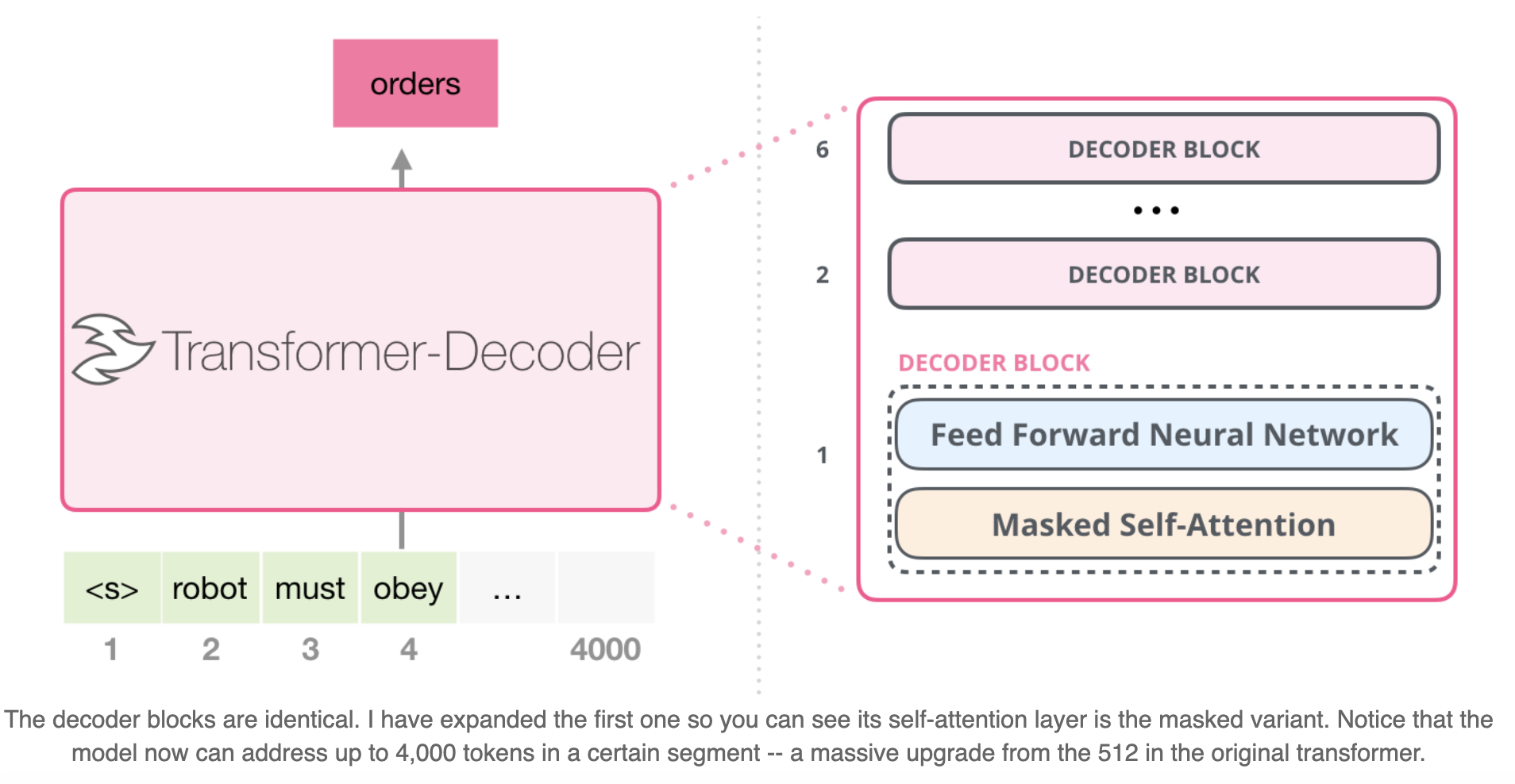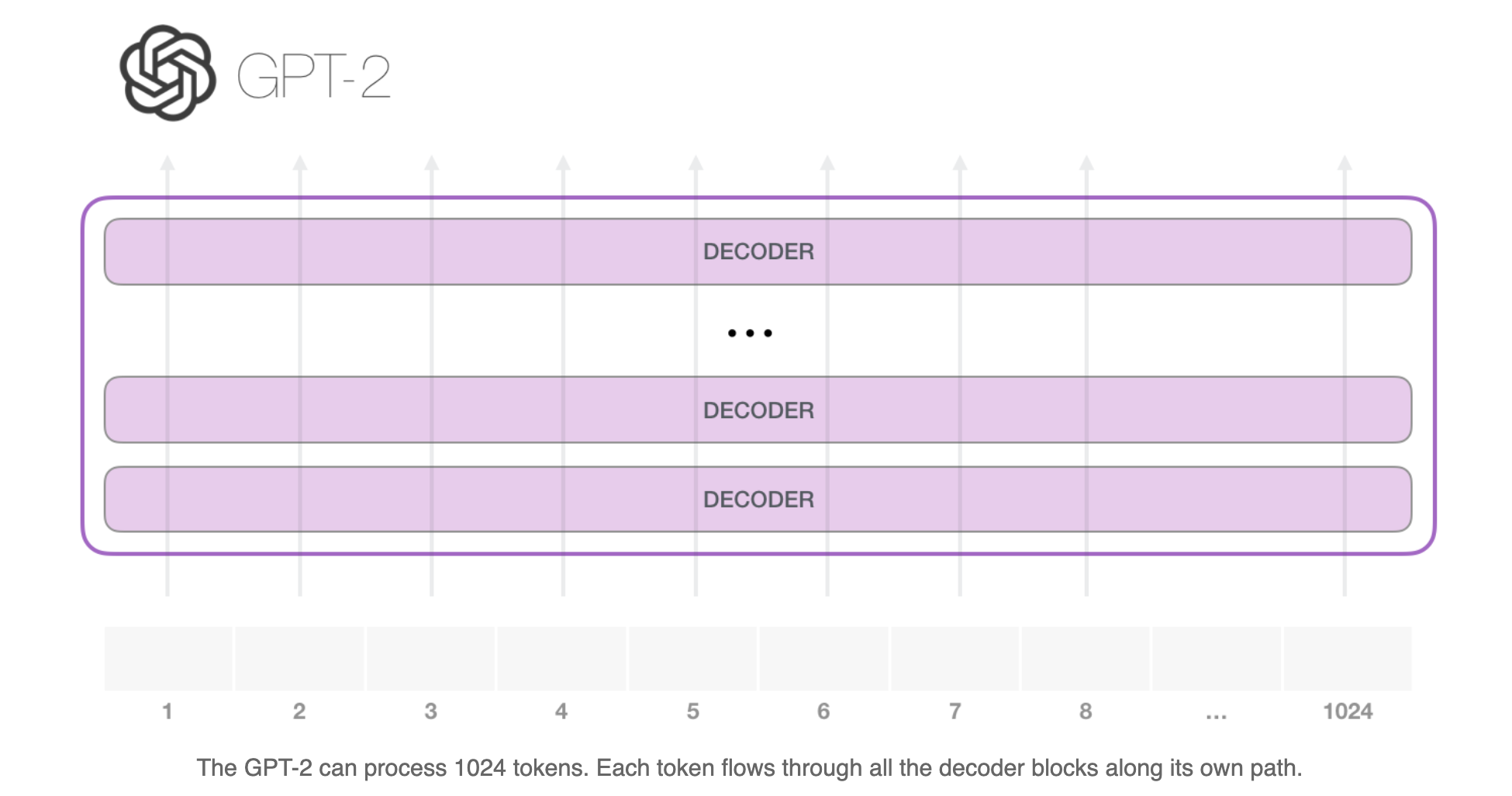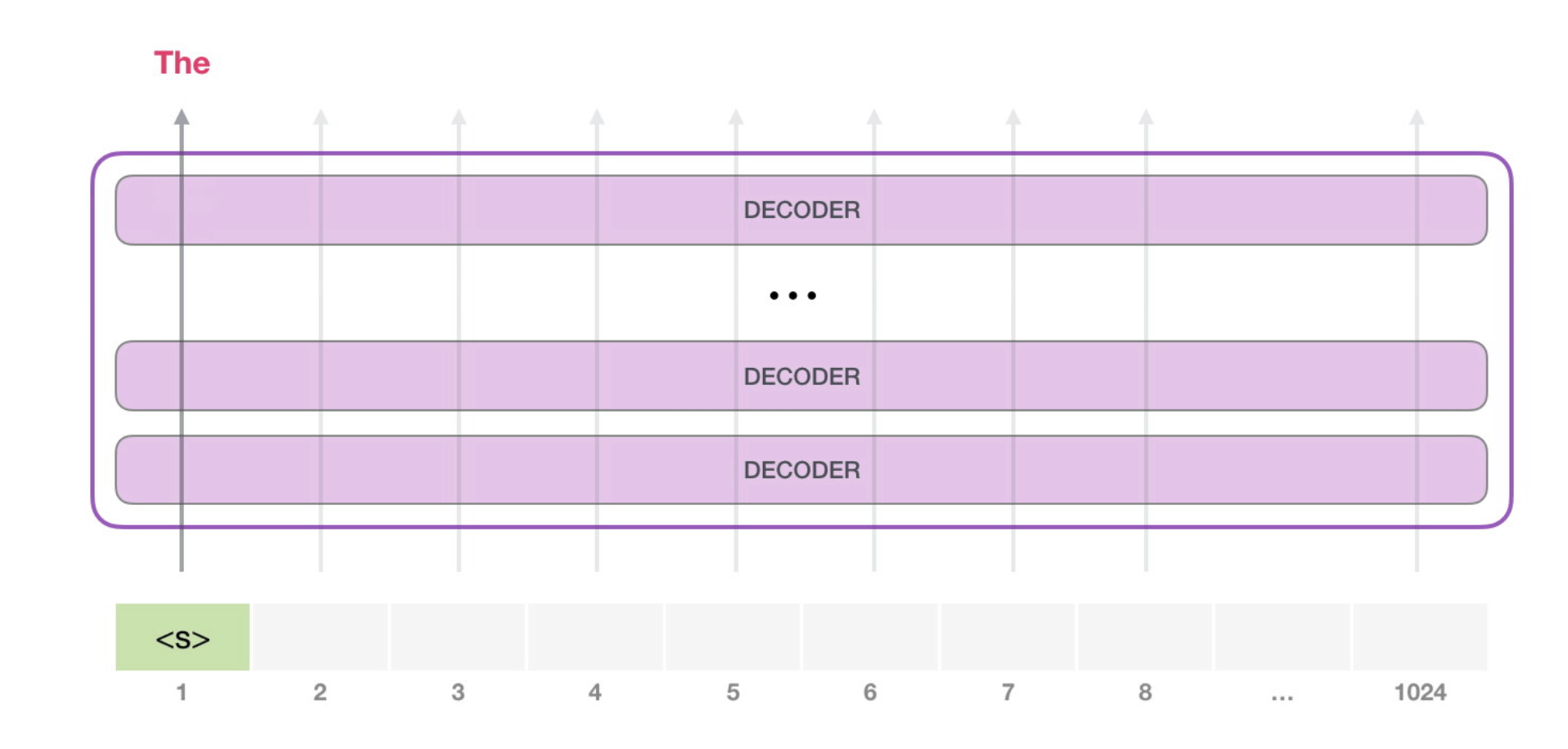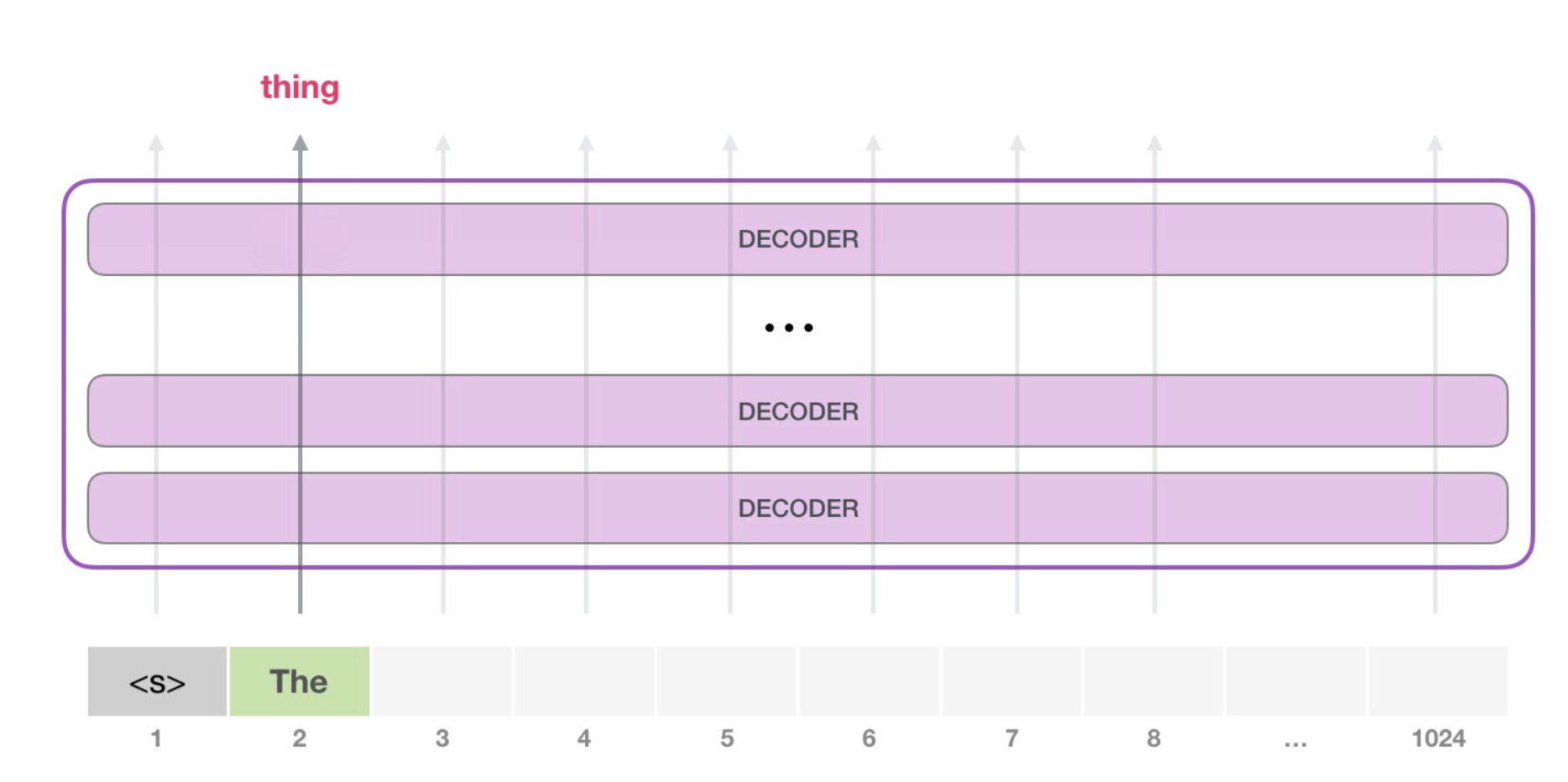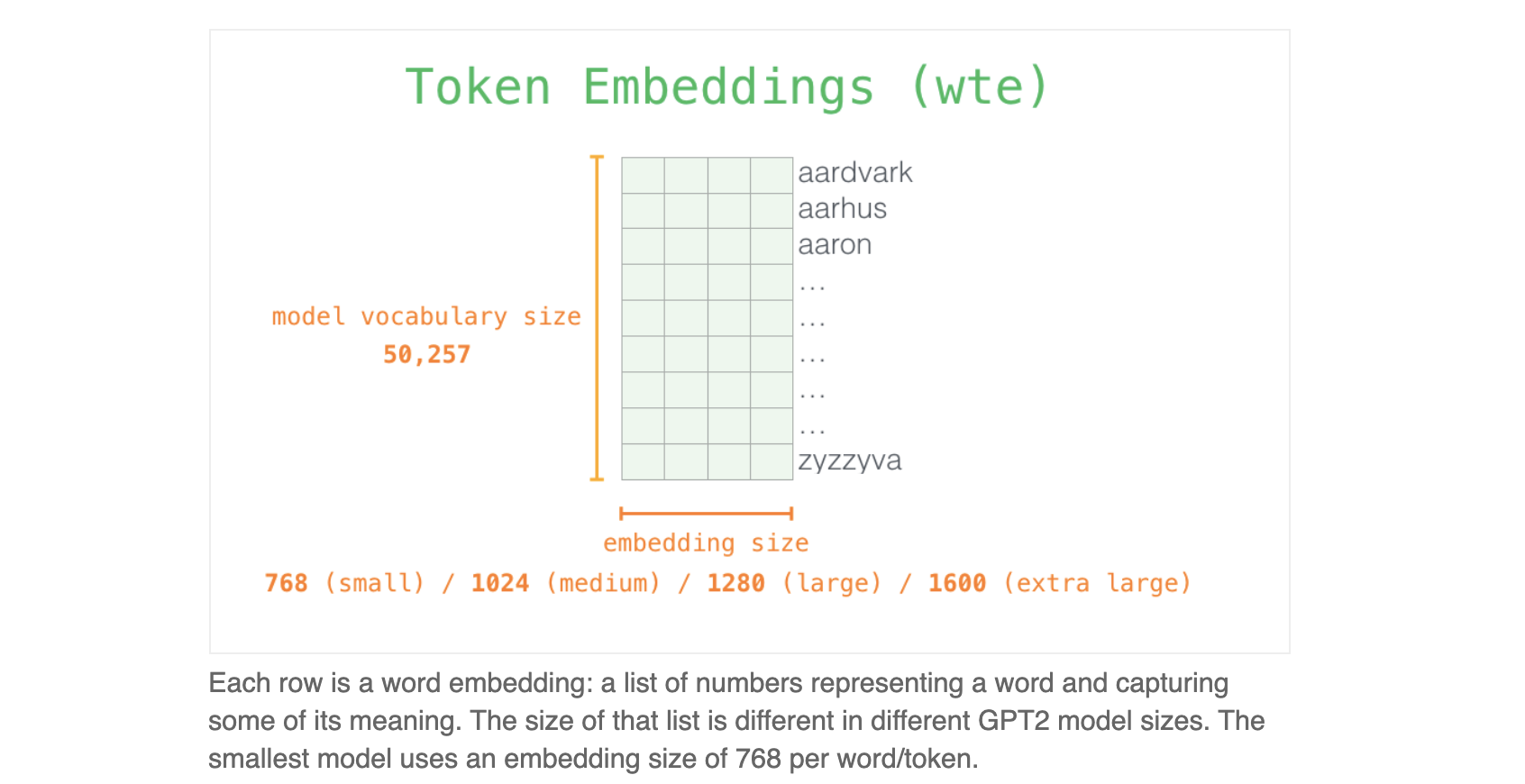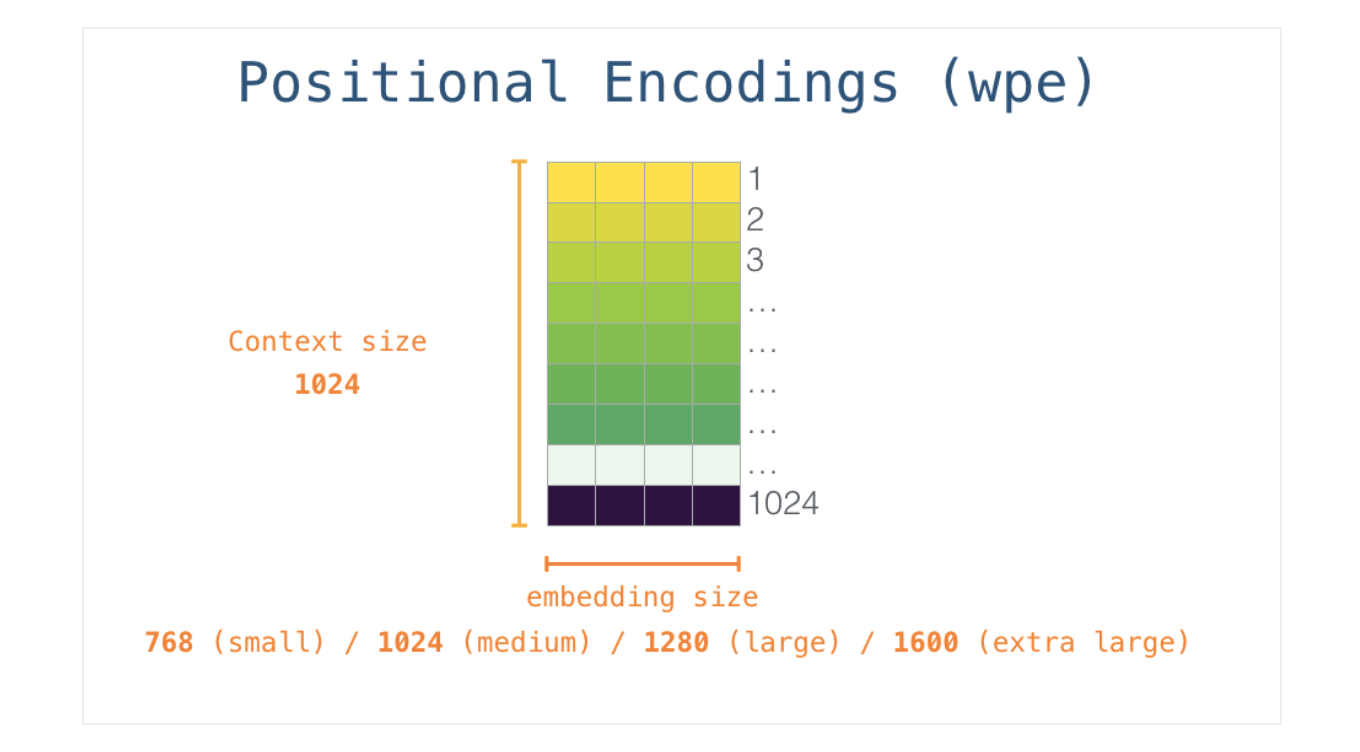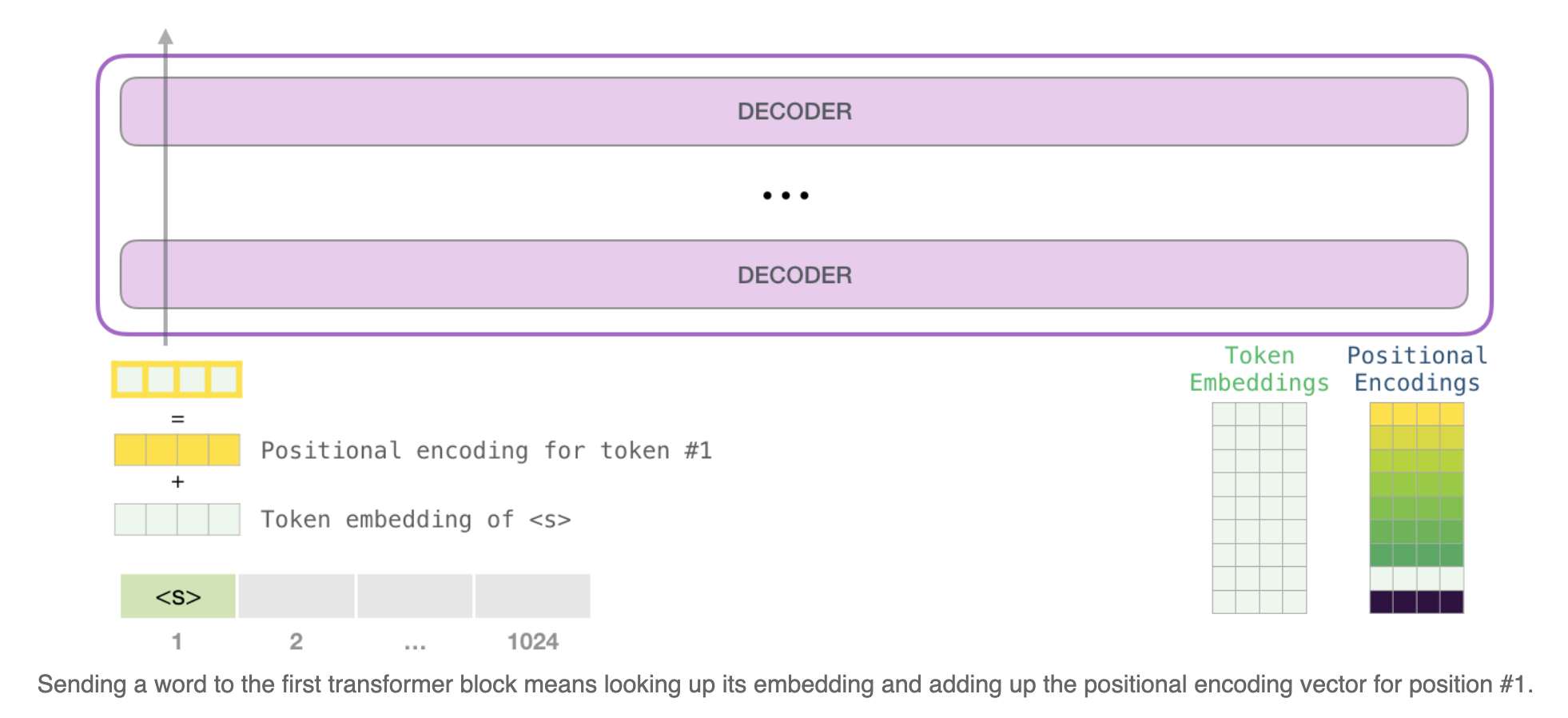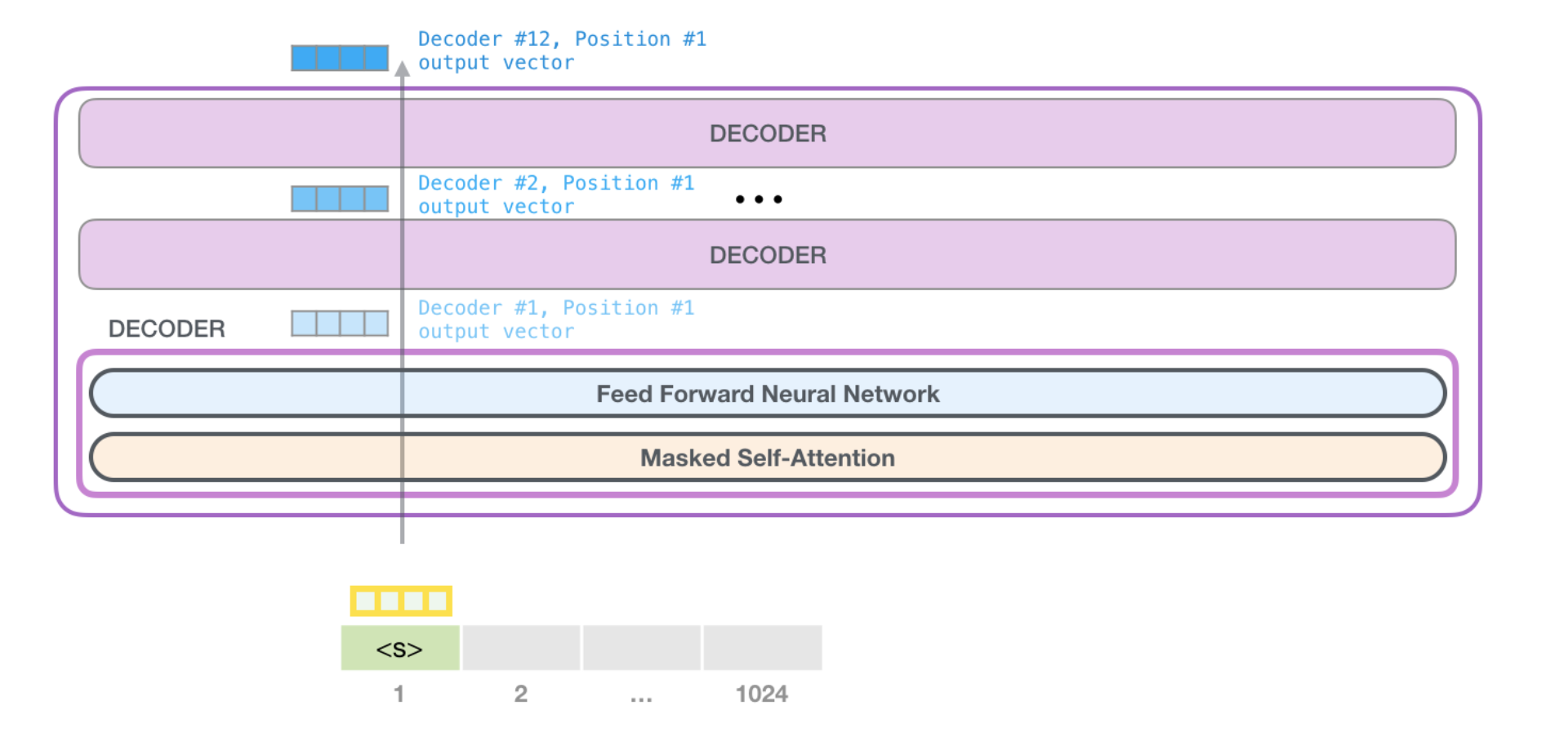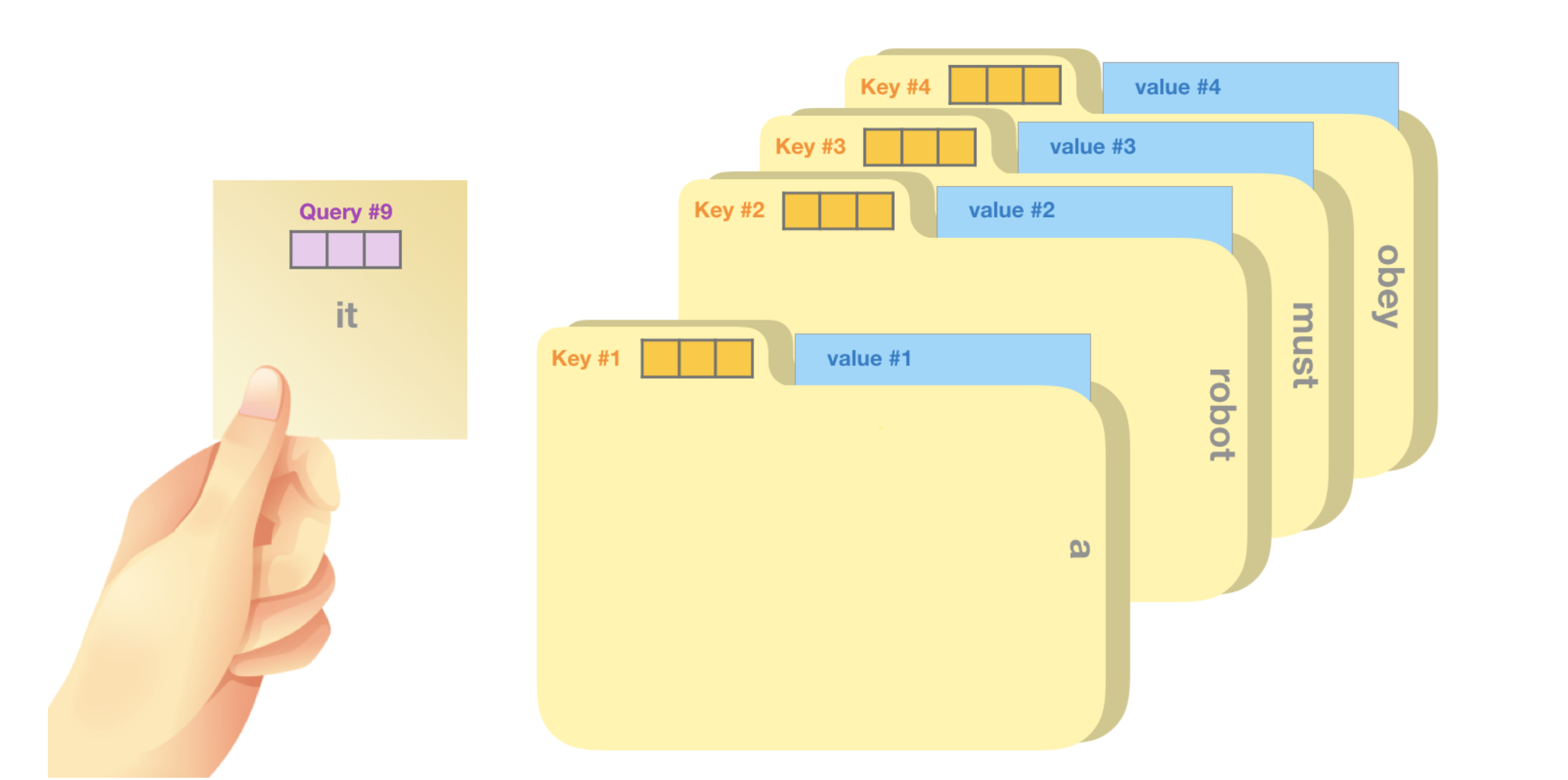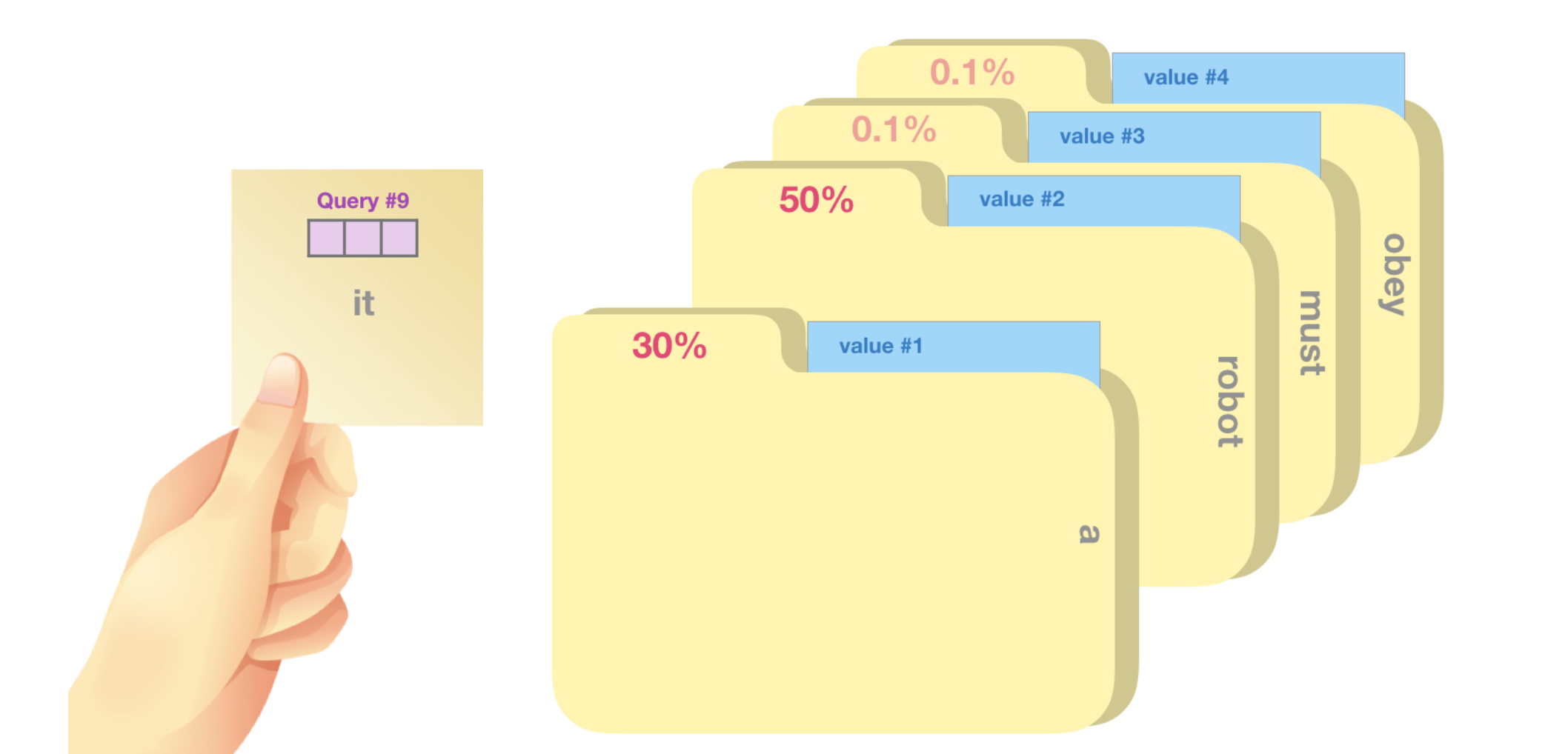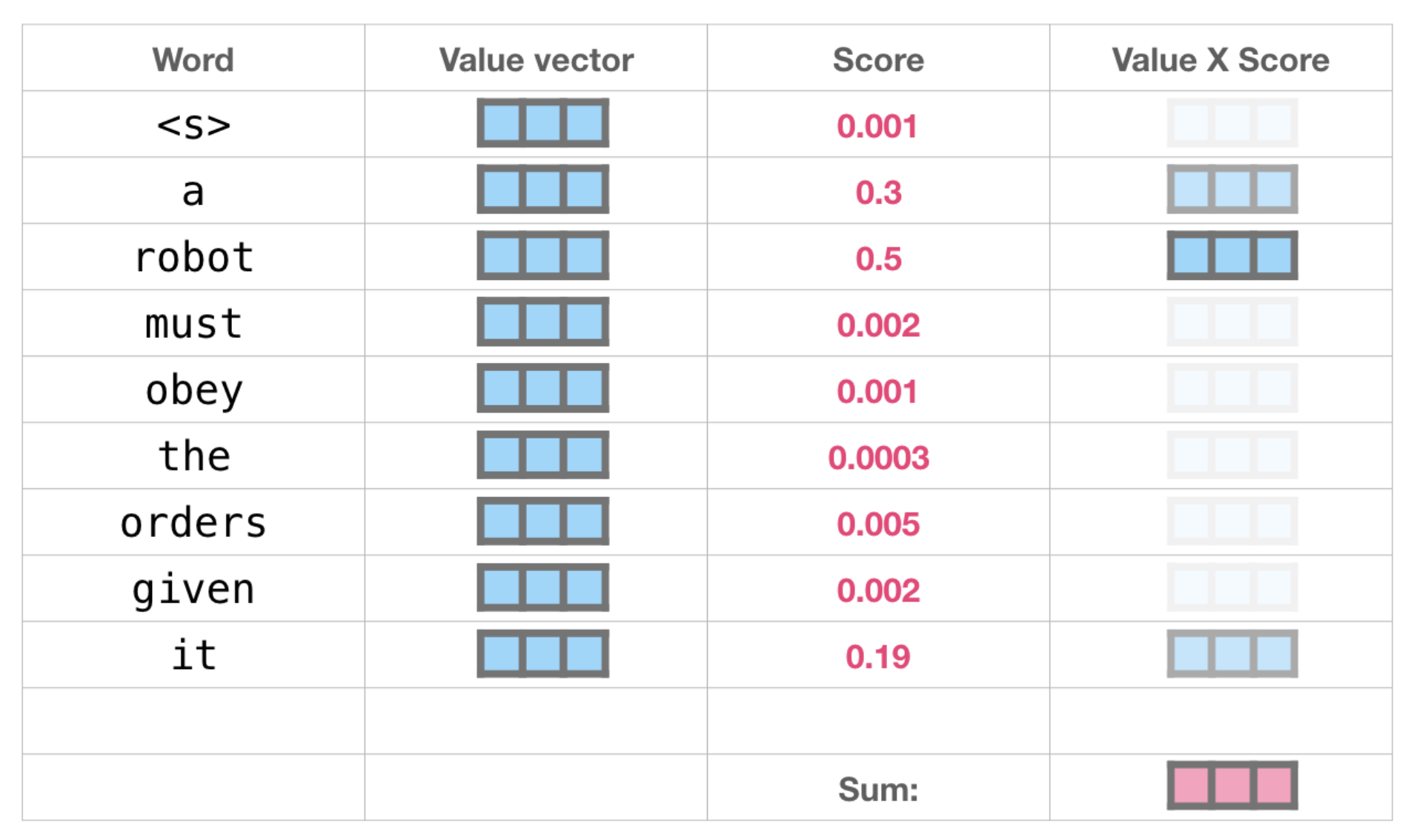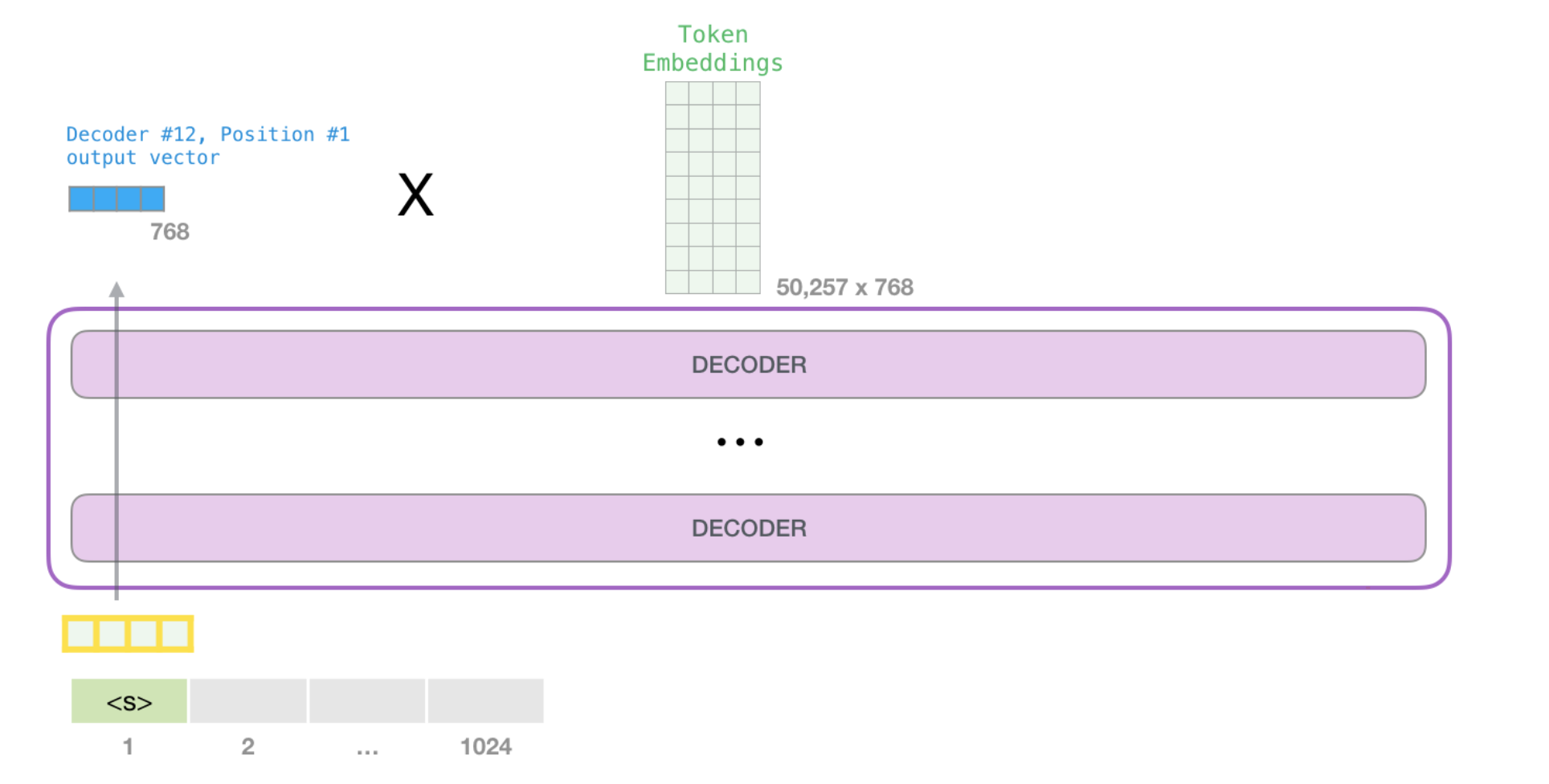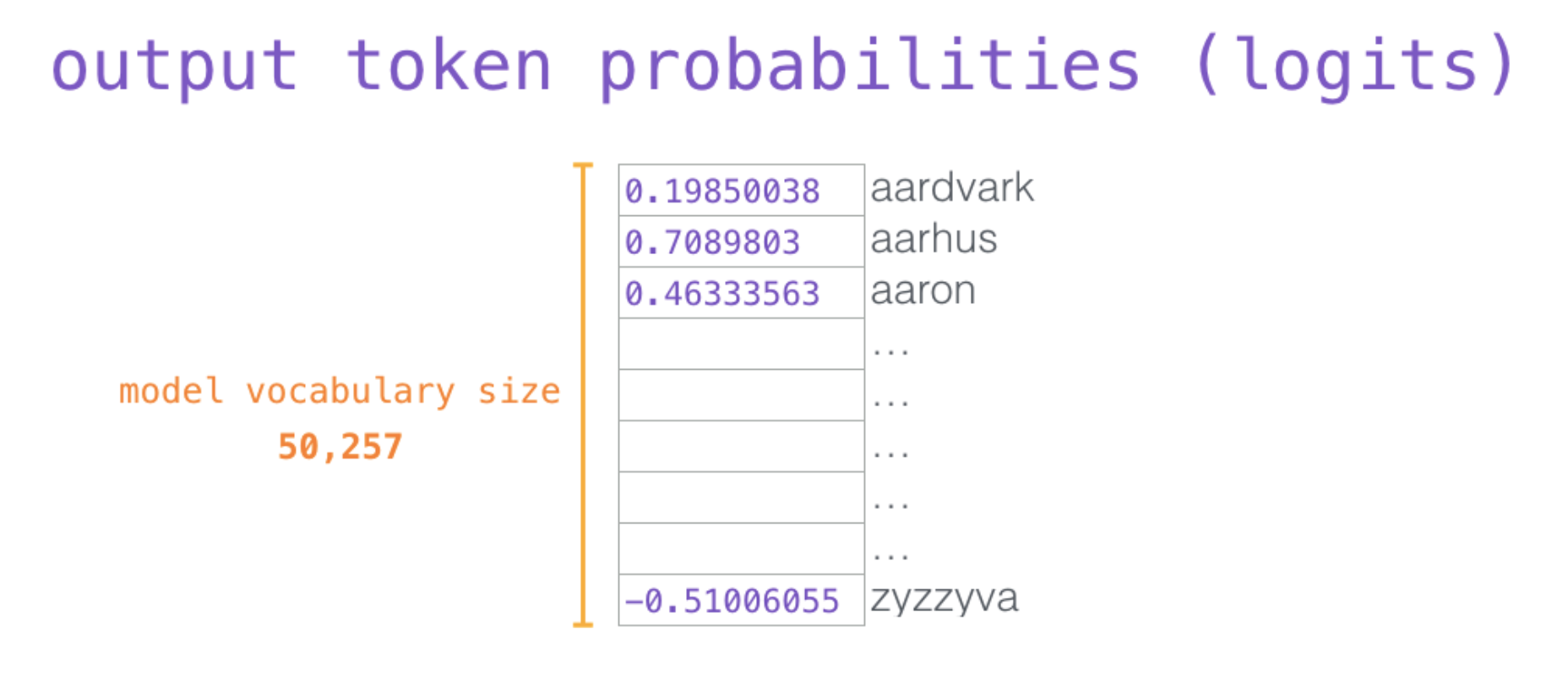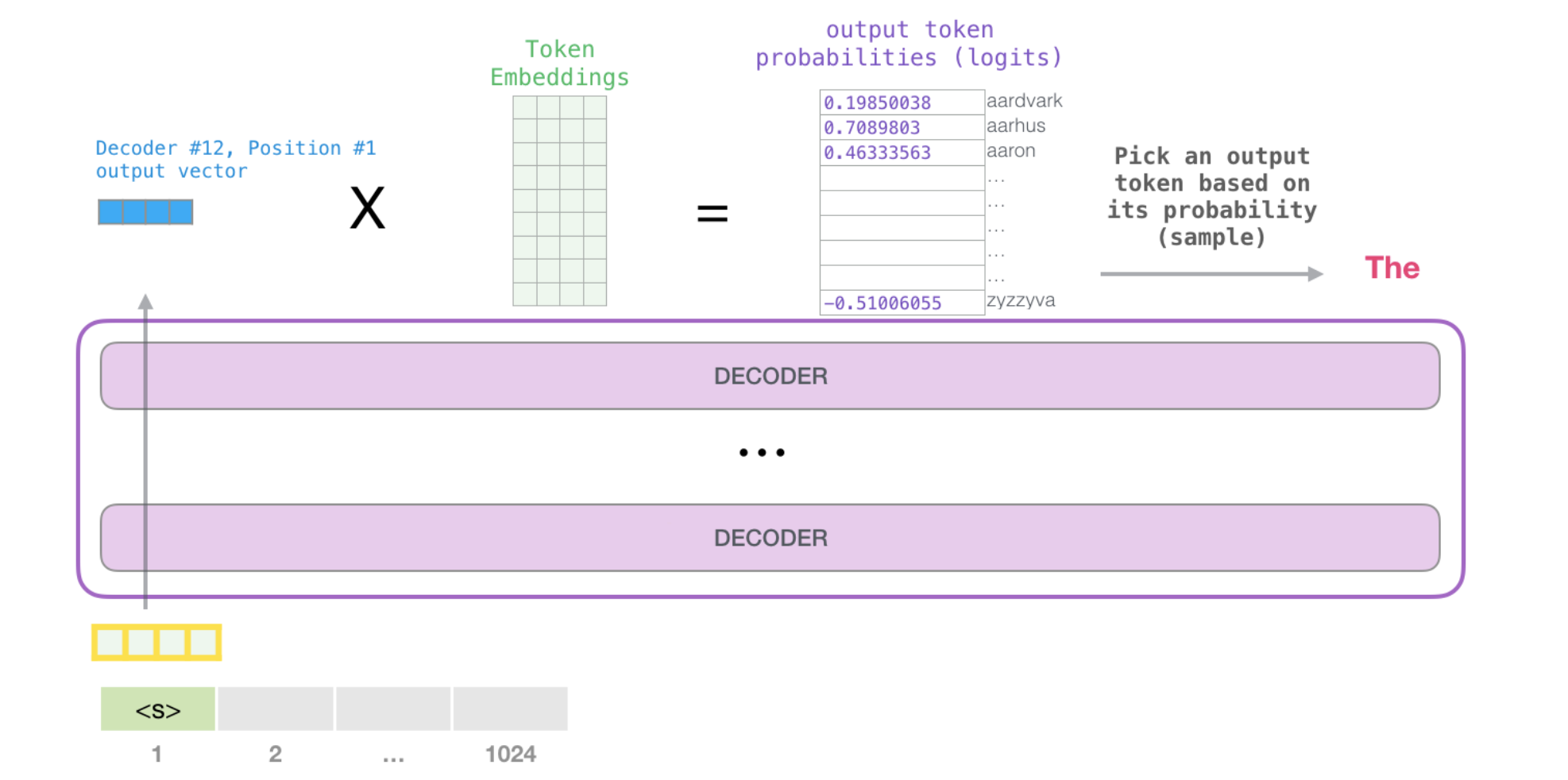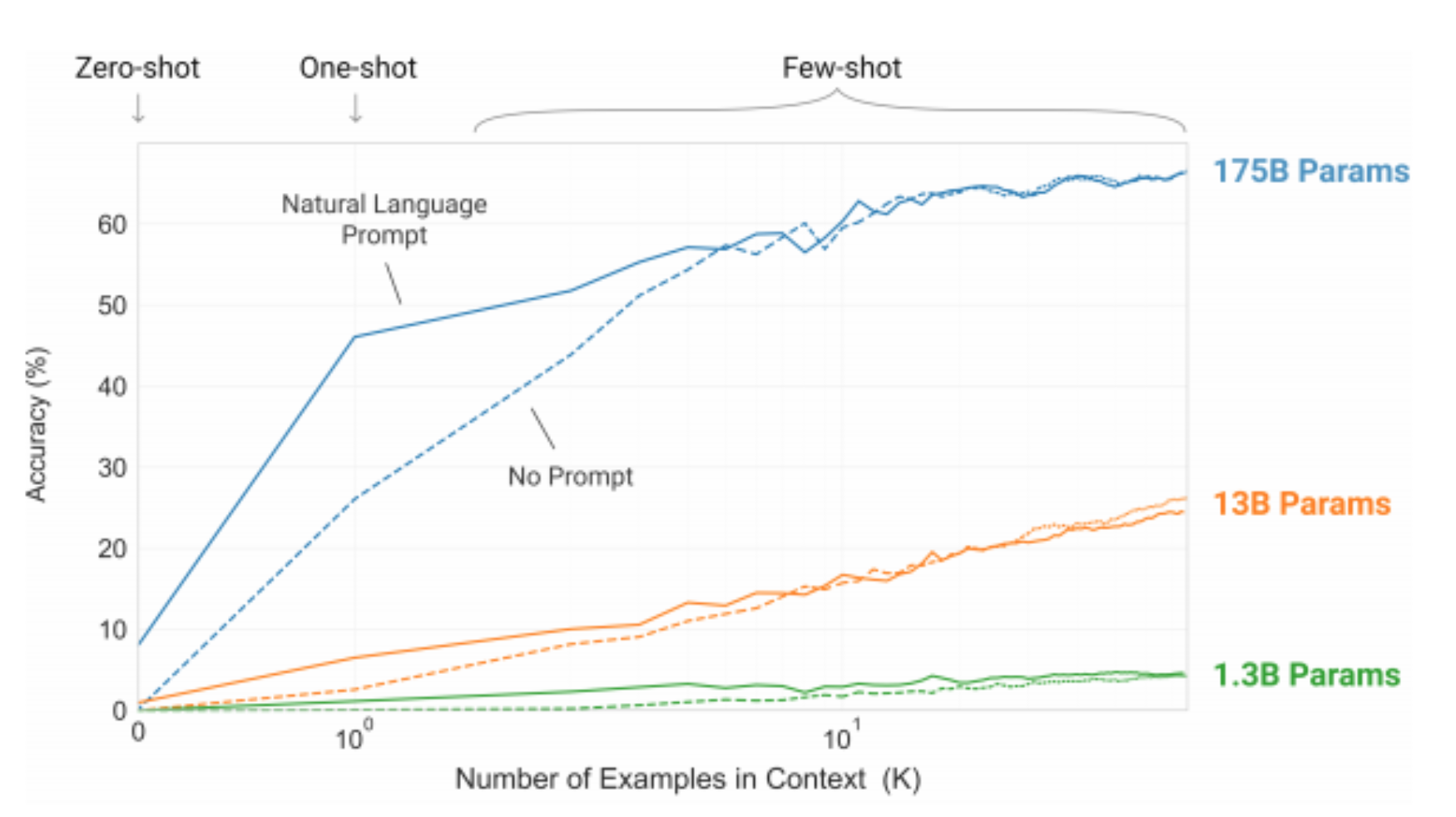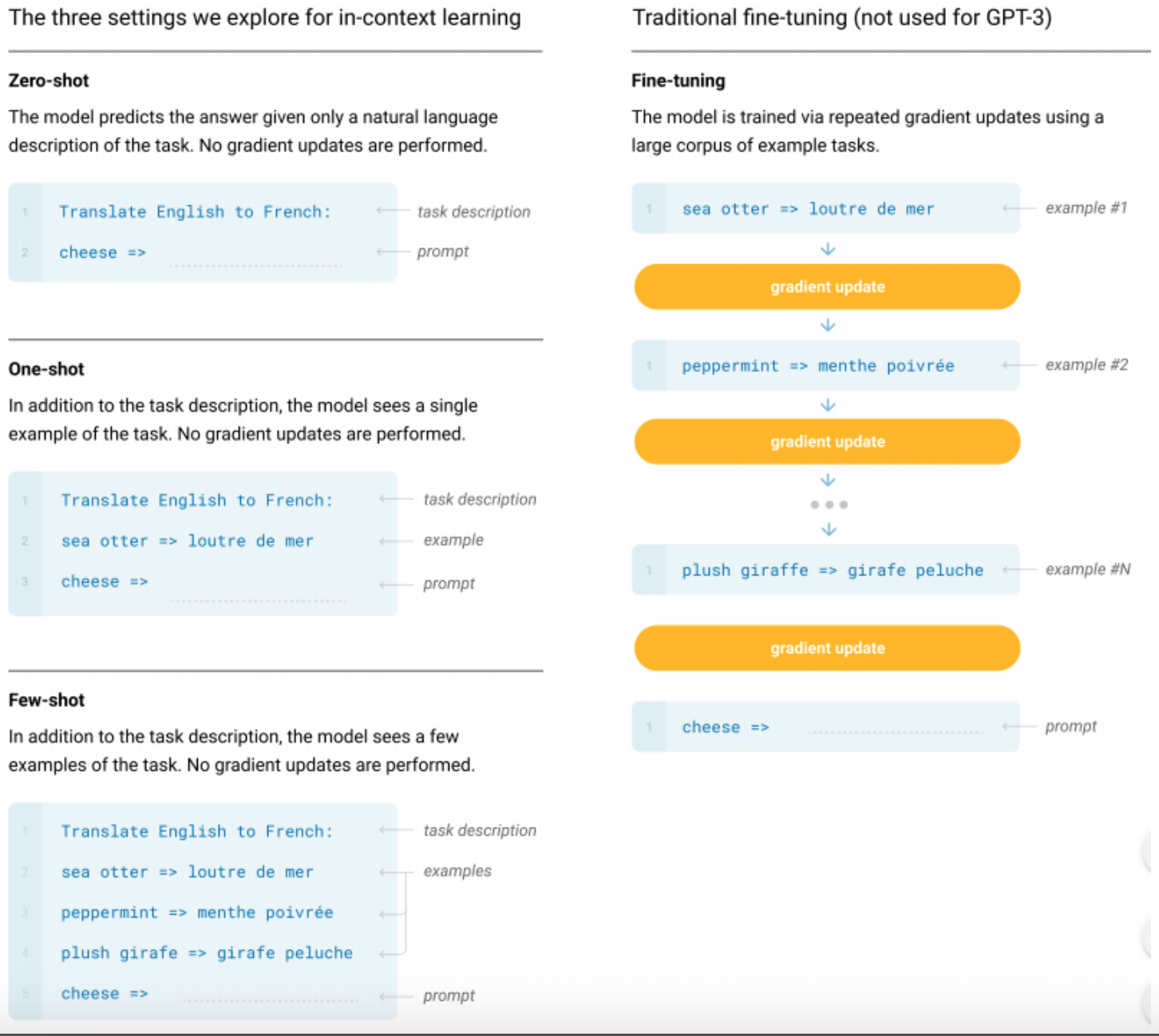GPT is the Transformer based model that is proposed by OpenAI. In this post, let’s take a look at the GPT variant models.
GPT
OpenAI GPT model was proposed in Improving Language Understanding by Generative Pre-Training [1] by Alec Radford, Karthik Narasimhan, Tim Salimans and Ilya Sutskever. It’s a causal (unidirectional) transformer pre-trained using language modeling on a large corpus will long range dependencies, the Toronto Book Corpus.
- GPT-1 largely follows the original transformer work
- Authors trained a 12-layer decoder-only transformer with masked self-attention heads (768 dimensional states and 12 attention heads).
- For the position-wise feed-forward networks, 3072 dimensional inner states has been used.
- Adam max learning rate of 2.5e-4. (later GPT-3 for this model size uses 6e-4)
- LR decay: increased linearly from zero over the first 2000 updates and annealed to 0 using a cosine schedule
- It has been trained for 100 epochs on minibatches of 64 randomly sampled, contiguous sequences of 512 tokens.
- Since layernorm is used extensively throughout the model, a simple weight initialization of N(0, 0.02) was sufficient
- bytepair encoding (BPE) vocabulary with 40,000 merges
- residual, embedding, and attention dropouts with a rate of 0.1 for regularization.
- modified version of L2 regularization proposed in (37), with w = 0.01 on all non bias or gain weights
- For the activation function, we used the Gaussian Error Linear Unit (GELU).
- We used learned position embeddings instead of the sinusoidal version proposed in the original work
- For finetuning: We add dropout to the classifier with a rate of 0.1. learning rate of 6.25e-5 and a batchsize of 32. 3 epochs.
- A linear learning rate decay schedule with warmup over 0.2% of training. λ was set to 0.5.
- GPT-1 model is 12 layers and d_model 768, ~117M params
Tips for using GPT
GPT is a model with absolute position embeddings so it’s usually advised to pad the inputs on the right rather than the left.
GPT was trained with a causal language modeling (CLM) objective and is therefore powerful at predicting the next token in a sequence.
GPT-2
OpenAI GPT-2 model was proposed in Language Models are Unsupervised Multitask Learners [2]. It’s a causal (unidirectional) transformer pre-trained using language modeling on a very large corpus of ~40 GB of text data.
Basically, there were no much difference between the architecture of GPT and GPT-2 model. Simply, they just increase the size of the GPT model to generate GPT-2, so that they could train the model with much bigger dataset (40GB of text dataset). However, the GPT-2 model actually outperformed the original GPT model. Here, we could find that increasing the size of the neural network actually helps the model to increase the performance.
- LayerNorm was moved to the input of each sub-block, similar to a pre-activation residual network
- an additional layer normalization was added after the final self-attention block.
- modified initialization which accounts for the accumulation on the residual path with model depth is used.
- the vocabulary is expanded to 50,257
- increase the context size from 512 to 1024 tokens
- larger batch-size of 512 is used
- GPT-2 used 48 layers and d_model 1600 (vs. original 12 layers and d_model 768). ~1.542B params
What is GPT-2
The GPT-2 is basically the next word prediction feature of a keyboard app, but one that is much larger and more sophisticated than what your phone has. The GPT-2 was trained on a massive 40GB dataset called WebText that the OpenAI researchers crawled from the internet as part of the research effort. To compare in terms of storage size, the keyboard app I use, SwiftKey, takes up 78MBs of space. The smallest variant of the trained GPT-2, takes up 500MBs of storage to store all of its parameters. The largest GPT-2 variant is 13 times the size so it could take up more than 6.5 GBs of storage space.
One great way to experiment with GPT-2 is using the AllenAI GPT-2 Explorer. It uses GPT-2 to display ten possible predictions for the next word (alongside their probability score). You can select a word then see the next list of predictions to continue writing the passage.
Transformers for Language Modeling
The original transformer model is made up of an encoder and decoder – each is a stack of what we can call transformer blocks. That architecture was appropriate because the model tackled machine translation – a problem where encoder-decoder architectures have been successful in the past.
A lot of the subsequent research work saw the architecture shed either the encoder or decoder, and use just one stack of transformer blocks – stacking them up as high as practically possible, feeding them massive amounts of training text, and throwing vast amounts of compute at them (hundreds of thousands of dollars to train some of these language models, likely millions in the case of AlphaStar).
How high can we stack up these blocks? It turns out that’s one of the main distinguishing factors between the different GPT2 model sizes:
One difference from BERT
The GPT-2 is built using transformer decoder blocks. BERT, on the other hand, uses transformer encoder blocks. But one key difference between the two is that GPT2, like traditional language models, outputs one token at a time.
The way these traditional language models actually work is that after each token is produced, that token is added to the sequence of inputs. And that new sequence becomes the input to the model in its next step. This is an idea called “auto-regression”. This is one of the ideas that made RNNs unreasonably effective.
The GPT2, and some later models like TransformerXL and XLNet are auto-regressive in nature. BERT is not. That is a trade off. In losing auto-regression, BERT gained the ability to incorporate the context on both sides of a word to gain better results. XLNet brings back autoregression while finding an alternative way to incorporate the context on both sides.
The Evolution of the Transformer Block
The initial transformer paper introduced two types of transformer blocks:
The Encoder Block
First is the encoder block:
The Decoder Block
Second, there’s the decoder block which has a small architectural variation from the encoder block – a layer to allow it to pay attention to specific segments from the encoder:
One key difference in the self-attention layer here, is that it masks future tokens – not by changing the word to [mask] like BERT, but by interfering in the self-attention calculation blocking information from tokens that are to the right of the position being calculated.
If, for example, we’re to highlight the path of position #4, we can see that it is only allowed to attend to the present and previous tokens:
It’s important that the distinction between self-attention (what BERT uses) and masked self-attention (what GPT-2 uses) is clear. A normal self-attention block allows a position to peak at tokens to its right. Masked self-attention prevents that from happening:
The Decoder-Only Block
Subsequent to the original paper, Generating Wikipedia by Summarizing Long Sequences [3] proposed another arrangement of the transformer block that is capable of doing language modeling. This model threw away the Transformer encoder. For that reason, let’s call the model the “Transformer-Decoder”. This early transformer-based language model was made up of a stack of six transformer decoder blocks:
These blocks were very similar to the original decoder blocks, except they did away with that second self-attention layer. A similar architecture was examined in Character-Level Language Modeling with Deeper Self-Attention [4] to create a language model that predicts one letter/character at a time.
The OpenAI GPT-2 model uses these decoder-only blocks.
Looking Inside GPT-2
| The simplest way to run a trained GPT-2 is to allow it to ramble on its own (which is technically called generating unconditional samples) – alternatively, we can give it a prompt to have it speak about a certain topic (a.k.a generating interactive conditional samples). In the rambling case, we can simply hand it the start token and have it start generating words (the trained model uses < | endoftext | > as its start token. Let’s call it <s> instead). |
The model only has one input token, so that path would be the only active one. The token is processed successively through all the layers, then a vector is produced along that path. That vector can be scored against the model’s vocabulary (all the words the model knows, 50,000 words in the case of GPT-2). In this case we selected the token with the highest probability, ‘the’. But we can certainly mix things up – you know how if you keep clicking the suggested word in your keyboard app, it sometimes can stuck in repetitive loops where the only way out is if you click the second or third suggested word. The same can happen here. GPT-2 has a parameter called top-k that we can use to have the model consider sampling words other than the top word (which is the case when top-k = 1).
In the next step, we add the output from the first step to our input sequence, and have the model make its next prediction:
Notice that the second path is the only that’s active in this calculation. Each layer of GPT-2 has retained its own interpretation of the first token and will use it in processing the second token (we’ll get into more detail about this in the following section about self-attention). GPT-2 does not re-interpret the first token in light of the second token.
A Deeper Look Inside
Input Encoding
Let’s look at more details to get to know the model more intimately. Let’s start from the input. As in other NLP models we’ve discussed before, the model looks up the embedding of the input word in its embedding matrix – one of the components we get as part of a trained model.
So in the beginning, we look up the embedding of the start token <s> in the embedding matrix. Before handing that to the first block in the model, we need to incorporate positional encoding – a signal that indicates the order of the words in the sequence to the transformer blocks. Part of the trained model is a matrix that contains a positional encoding vector for each of the 1024 positions in the input.
With this, we’ve covered how input words are processed before being handed to the first transformer block. We also know two of the weight matrices that constitute the trained GPT-2.
A journey up the Stack
The first block can now process the token by first passing it through the self-attention process, then passing it through its neural network layer. Once the first transformer block processes the token, it sends its resulting vector up the stack to be processed by the next block. The process is identical in each block, but each block has its own weights in both self-attention and the neural network sublayers.
Self-Attention Recap
Language heavily relies on context. So, when the language model processes the sentence, it should know which word is referred to which word.
This is what self-attention does. It bakes in the model’s understanding of relevant and associated words that explain the context of a certain word before processing that word (passing it through a neural network). It does that by assigning scores to how relevant each word in the segment is, and adding up their vector representation.
Self-Attention Process
Self-attention is processed along the path of each token in the segment. The significant components are three vectors:
Query: The query is a representation of the current word used to score against all the other words (using their keys). We only care about the query of the token we’re currently processing.
Key: Key vectors are like labels for all the words in the segment. They’re what we match against in our search for relevant words.
Value: Value vectors are actual word representations, once we’ve scored how relevant each word is, these are the values we add up to represent the current word.
A crude analogy is to think of it like searching through a filing cabinet. The query is like a sticky note with the topic you’re researching. The keys are like the labels of the folders inside the cabinet. When you match the tag with a sticky note, we take out the contents of that folder, these contents are the value vector. Except you’re not only looking for one value, but a blend of values from a blend of folders.
Multiplying the query vector by each key vector produces a score for each folder (technically: dot product followed by softmax).
We multiply each value by its score and sum up – resulting in our self-attention outcome.
This weighted blend of value vectors results in a vector that paid 50% of its “attention” to the word “robot”, 30% to the word “a”, and 19% to the word “it”. Later in the post, we’ll got deeper into self-attention. But first, let’s continue our journey up the stack towards the output of the model.
Model Output
When the top block in the model produces its output vector (the result of its own self-attention followed by its own neural network), the model multiplies that vector by the embedding matrix.
Recall that each row in the embedding matrix corresponds to the embedding of a word in the model’s vocabulary. The result of this multiplication is interpreted as a score for each word in the model’s vocabulary.
We can simply select the token with the highest score (top_k = 1). But better results are achieved if the model considers other words as well. So a better strategy is to sample a word from the entire list using the score as the probability of selecting that word (so words with a higher score have a higher chance of being selected). A middle ground is setting top_k to 40, and having the model consider the 40 words with the highest scores.
With that, the model has completed an iteration resulting in outputting a single word. The model continues iterating until the entire context is generated (1024 tokens) or until an end-of-sequence token is produced.
Tips for using GPT-2
GPT-2 is a model with absolute position embeddings so it’s usually advised to pad the inputs on the right rather than the left.
GPT-2 was trained with a causal language modeling (CLM) objective and is therefore powerful at predicting the next token in a sequence.
GPT-3
On May 2020, Tom B. Brown et al. [6] proposed the GPT-3, which surprised everyone. Similar to the previous GPT models, this model also inference the result by predicting the next word with attention mechanism.
The most special thing in the GPT-3 is that the size of the model is extremely huge, compare to all models that we faced with (until 2020). The GPT-2 model was considered as a big and powerful model, since it has about 1.5 billion parameters. However, GPT-3 has about 175 billion parameters. Clearly, there is no special differences between the architecture of GPT-2 and GPT-3 - they just increase the size of the model, and it actually made the model extremely powerful.
- GPT-3: 96 layers, 96 heads, with d_model of 12,288 (175B parameters).
- GPT-1-like: 12 layers, 12 heads, d_model 768 (125M)
- uses the same model and architecture as GPT-2, including the modified initialization, pre-normalization, and reversible tokenization described therein
- uses alternating dense and locally banded sparse attention patterns in the layers of the transformer, similar to the Sparse Transformer
- Always have the feedforward layer four times the size of the bottleneck layer, dff = 4 ∗ dmodel
- all models use a context window of nctx = 2048 tokens.
- Adam with β1 = 0.9, β2 = 0.95, and eps = 10−8
- All models use weight decay of 0.1 to provide a small amount of regularization.
- (NOTE: GPT-1 used 0.01 I believe, see above)
- clip the global norm of the gradient at 1.0
- Linear LR warmup over the first 375 million tokens.
- Then use cosine decay for learning rate down to 10% of its value, over 260 billion tokens.
- gradually increase the batch size linearly from a small value (32k tokens) to the full value over the first 4-12 billion tokens of training, depending on the model size.
- full 2048-sized time context window is always used, with a special END OF DOCUMENT token delimiter
Pretrained Language Models could be used for downstream tasks
The main point that the GPT-3 actually surprised everyone is that the GPT-3 did not use the finetuning. Since the size of the GPT-3 is too large, researchers decided to not to use the finetuning the model. This is because finetuning an extrememly large model is extremely hard. Instead finetuning the model, GPT-3 trained with self-supervised pretraining and in-context learning.
So, the training loop of the GPT-3 has 2 different loops - pretraining as a outer loop, and in-context learnings as inner loops. Basically, the incontext-learning is a training method that makes the model to infer what to do for the given task where doing the actual inference at the same time. To accomplish this, GPT-3 was trained with prompt-based learning. As it’s name depicts, the prompt learning is a method that uses the prompt. It is one of the in-context learning methods that is used for language models. By giving both prompt that describes the task and the text data that should be used for actual inference, GPT-3 was able to learn new things via few shot learning. It is said that it might be possible to make a better and more generalised model if we increase both model size and training dataset, and train it with in-context learning method.
AGI - we are almost there now
AGI, Artifical General Intelligence, is the hypothetical intelligence of a machine that has the capacity to understand or learn any intellectual task that a human being can. It is a primary goal of some artificial intelligence research and a common topic in science fiction and futures studies. AGI can also be referred to as strong AI, full AI, or general intelligent action.
Humans do not require large supervised datasets to learn most language tasks, but neural networks do (until now). However, the GPT-3 does not. The special thing about GPT-3 is that the GPT-3 achieved extremely good results for various NLP tasks without fine-tuning for the benchmark under consideration, but achieved by the language model without any further information (“zero-shot”) or with little additional information (“one-shot” or “few-shot”).
Problems that GPT-3 has
Apparently, GPT-3 achieved brilliant achievements. However, it still has problems that should be fixed.
First, GPT-3 actually works well for almost all NLP tasks, however, this does not mean that it achieved the SOTA for almost all NLP tasks. In other words, the GPT-3 works well with most of the NLP tasks, however, the accuracy (or performance) is not as good as SOTA model, which is highly optimised to the specific task.
Second, it does not know about the physical world. For example, when you give a question “Will the cheese melt when you put the cheese in the refridgerator?”, then the GPT-3 will answer “Yes, it will”. Clearly, the cheese will not melt when we put it in the refridgerator. The reason that this happened is because GPT-3 learned everything from texts. So, it does not know the facts that are not in the training dataset. If it could understand the question, it should be able to answer with “correct” answer. To overcome this issue, we could probably make the model to learn the knowledge not onlt from texts, but also from vision data.
Third, GPT-3 is too big. The huge model takes a lot of time and computing resources for training, since there are too many parameters to train. Also, a huge model is not good for utilization. The huge model takes more operations for single inference, and this will make the application slower. Perhaps, this might be solved if the price of the GPU becomes much cheaper.
Forth, the model does not “memorize”. Basically, there is not concept of “memory” in Transformer model. It just generates outputs by calculating the results from last N input tokens (where N is the size of the input).
Fifth, the GPT-3 just inference the result by predicting the next word. Clearly, this is weird, since humans do not learn things by predicting the next word. Due to this reason, many researchers criticized that the GPT-3 is not doing fancy things, it just predicts the next word statistically, and the reason why it works well is because it has huge amount of parameters.
ImageGPT
ImageGPT is a GPT-based model for image generation task.
- When working with images, we pick the identity permutation πi = i for 1 ≤ i ≤ n, also known as raster order.
- creates own 9-bit color palette by clustering (R, G, B) pixel values using k-means with k = 512.
- The largest model, iGPT-XL, contains L = 60 layers and uses an embedding size of d = 3072 for a total of 6.8B parameters.
- The next largest model, iGPT-L, is essentially identical to GPT-2 with L = 48 layers, but contains a slightly smaller embedding size of d = 1536 (vs 1600) for a total of 1.4B parameters.
- uses the same model code as GPT-2, except that the model is initialized weights in the layerdependent fashion as in Sparse Transformer (Child et al., 2019) and zero-initialize all projections producing logits.
- They also train iGPT-M, a 455M parameter model with L = 36 and d = 1024
- iGPT-S, a 76M parameter model with L = 24 and d = 512 (assuming 8 attention heads)
- When pre-training iGPT-XL, we use a batch size of 64 and train for 2M iterations, and for all other models we use a batch size of 128 and train for 1M iterations.
- Adam with β1 = 0.9 and β2 = 0.95
- The learning rate is warmed up for one epoch, and then decays to 0
- did not use weight decay because applying a small weight decay of 0.01 did not change representation quality.
- iGPT-S lr 0.003
- No dropout is used.
References
[1] Alec Radford, Karthik Narasimhan, Tim Salimans, Ilya Sutskever. Improving Language Understanding by Generative Pre-Training [1]
[2] Alec Radford, Jeffrey Wu, Rewon Child, David Luan, Dario Amodei, Ilya Sutskever. Language Models are Unsupervised Multitask Learners [2]
[3] Peter J. Liu, Mohammad Saleh, Etienne Pot, Ben Goodrich, Ryan Sepassi, Lukasz Kaiser, Noam Shazeer. Generating Wikipedia by Summarizing Long Sequences
[4] Rami Al-Rfou, Dokook Choe, Noah Constant, Mandy Guo, Llion Jones. Character-Level Language Modeling with Deeper Self-Attention
[5] Jay Alammar. The Illustrated GPT-2 (Visualizing Transformer Language Models)
[6] Tom B. Brown, Benjamin Mann, Nick Ryder, Melanie Subbiah, Jared Kaplan, Prafulla Dhariwal, Arvind Neelakantan, Pranav Shyam, Girish Sastry, Amanda Askell, Sandhini Agarwal, Ariel Herbert-Voss, Gretchen Krueger, Tom Henighan, Rewon Child, Aditya Ramesh, Daniel M. Ziegler, Jeffrey Wu, Clemens Winter, Christopher Hesse, Mark Chen, Eric Sigler, Mateusz Litwin, Scott Gray, Benjamin Chess, Jack Clark, Christopher Berner, Sam McCandlish, Alec Radford, Ilya Sutskever, Dario Amodei. Language Models are Few-Shot Learners
[7] OpenAI blog. ImageGPT
